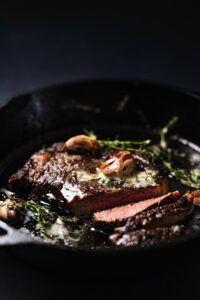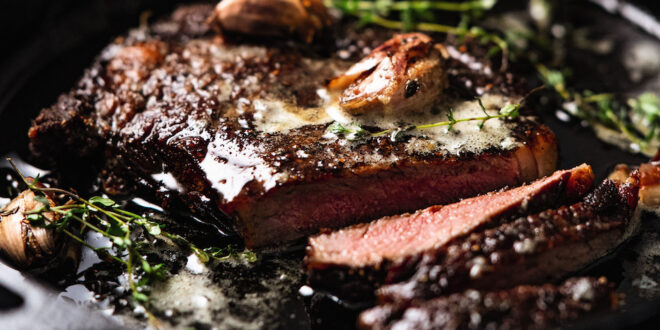Recipe courtesy of Dinner by Nagi Maehashi, Macmillan Publishers, RRP $49.99
Choosing a steak around 2–2.5 cm thick means you don’t need to mess around finishing it in the oven. This is perfect for fast midweek meals – who’s got time for that sort of fluff on a Monday night!? The basting method isn’t just about showing off (but, well, that too!), it’s also about getting more flavour on the steak as well as being a good cooking technique. The butter has a tempering effect and moderates heat. This means more evenly cooked steak, and less smoking/burning of fats and meat in the pan.
Serves: 1–2 | prep: 3 minutes | cook: 10 minutes
 Ingredients
Ingredients
- 1–2 x 300 g scotch fillets1, 2–2.5 cm thick, removed from the fridge 30 minutes prior to cooking, patted dry with paper towels
- 1⁄2 tsp cooking salt* per steak
- 2 pinches black pepper per steak
- 1 1⁄2 tbsp canola oil
- 50 g unsalted butter2, cut into 1.25 cm cubes
- 5 garlic cloves*, smashed
- 6 thyme sprigs (or 3 rosemary sprigs)
Season – Sprinkle each side of the steak with salt and pepper.
Turn your exhaust fan on high and open the windows! Set a rack over a tray for resting the steak3 (optional, but recommended).
Heat the oil in a cast-iron frying pan over high heat just until you see the first wisps of smoke.
Cook steak – Use tongs to hold the steak upright (if cooking two steaks, grip both together at once) and sear the fat side of the steak – around 11⁄2 minutes in total. (Skip this step if the steak does not have fat on the sides.) Once the side is nicely coloured, lay the steak down in the pan, which should be smoking hot by now!
Cook for 2 1⁄2 minutes until you get a great crust, then turn the steak. Leave the steak for 1 minute, then toss in the butter, garlic and thyme (the thyme will splutter!). Turn the heat down to medium–high.
Baste – As soon as the butter melts (10 seconds), tilt the pan slightly so the butter pools on one side. Using a large spoon, continuously spoon the butter over the steak until it’s cooked to your liking – 1 1⁄2 minutes in total for medium–rare (internal temperature 51°C).
Rest – Transfer the steak to the rack3 and rest for 5–10 minutes. Never skip this step with steak! Serve – Transfer to serving plates and serve the steak with a bit of the butter from the pan (which is now brown butter!).
NOTES
- In my personal opinion, scotch fillet (aka boneless rib-eye) is the best cut of beef to cook as a pan-seared steak, followed by sirloin, T-bone, then rump. Sirloin and rump will take 45 seconds less to cook than a scotch fillet, and a T-bone steak will take the same time as a scotch fillet. Beef tenderloin, although very tender, has less beefy flavour. Also note this method of cooking is not suitable for flank, skirt or bavette. It is also not suitable for slow-cooking cuts of beef (like chuck, beef ribs or brisket) or lean thin steaks (such as ‘minute’ or ‘sizzle steak’ and beef schnitzels).
- You need this amount of butter whether cooking one or two steaks in order to have enough to baste. You won’t use all the butter for serving. Frankly, it’s so flavourful, though, it’s worth saving. Freeze it for up to 6 months, then melt and serve over the next steak you throw on the barbie where you can’t use this basting method.
- Resting steak on racks is best practice (good restaurants always do it) but I ordinarily don’t bother unless it really adds to the steak dish. For good steak, though, it’s worth it! The rack prevents the underside of the steak from sweating, which compromises the crust.










Join the Discussion
Type out your comment here:
You must be logged in to post a comment.